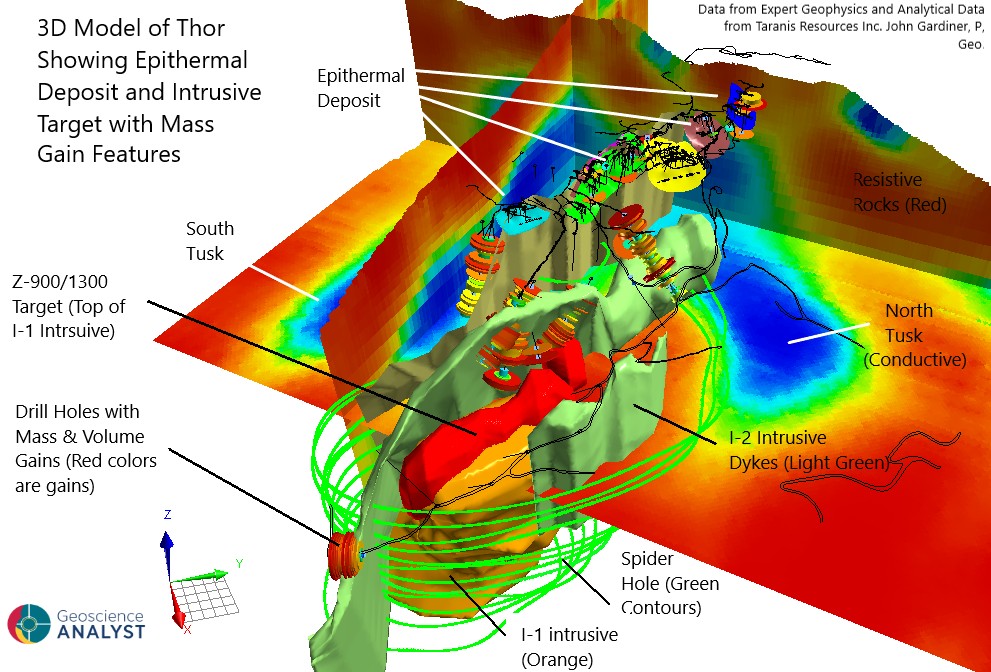
Making Every Drill Hole Count!
ESTES PARK, CO / ACCESS Newswire / April 9, 2025 / Taranis Resources Inc. ("Taranis" or the "Company") (TSX.V:TRO)(OTCQB:TNREF) is providing the fourth in a series of updates related to the 2024 deep drilling program at Thor, SE British Columbia. Taranis has finalized a mass-balance alteration study of the drill holes completed in 2024, which intersected the I-1 and I-2 intrusive rocks that contain anomalous gold, zinc, and arsenic. Mass-balance ("Gresen") alteration analysis is a well-known tool in measuring hydrothermal alteration for deeply buried intrusive targets. This method identifies large-scale geochemical changes (mass and volume changes) related to the hydrothermal alteration that accompanies intrusive-related mineral deposits. Using this method, Taranis can minimize future drilling costs by identifying areas of intense hydrothermal alteration. This approach is particularly useful when combined with magnetotelluric surveys that have already identified concealed targets. A 3D block model accompanies this News Release, showing the magnetotelluric model with the mass/volume geochemistry conducted in the 2024 drill holes.
Taranis completed specialized sampling of 252 drill core samples and a number of surface samples. These samples were analyzed for major elements, trace elements and rare-earth elements. At Thor, Light Rare Earth Elements ("LREE") are geochemically immobile, and these were used to construct isocons for each sample that measured the gain/loss of other chemical components in the rock. These were compared with visibly unaltered populations of rock including pelites, greywackes and calc-alkaline intrusive dykes. Mass/volume depletion is diagnostic of 'leaching' of the original host rock, whereas mass/volume addition is characteristic of deposition in the host rock by hydration, carbonation or the addition of quartz-carbonate veins. At Thor, areas of mass/volume gain are particularly sought after, as an underlying intrusive would have added silica, sodium, carbonate and other chemical components that commonly accompany metals such as gold, silver, zinc, lead and copper. Areas of mass/volume addition are areas which exploration should be directed as these will also have precious and base metal mineralization.
Epithermal Deposit
The epithermal veins at Thor that constitute the current Mineral Resource exhibit mass gains due to the introduction of silica, carbonate and other gangue minerals such as paragonite. Various other economically important sulfides including silver-bearing tetrahedrite, auriferous pyrite, sphalerite and chalcopyrite have also been introduced into the veins with the influx of hydrothermal fluids. From an alteration perspective, the chemical changes associated with these veins are relatively localized. The alteration zones around the epithermal veins show high mass/volume depletions indicating the wall rocks around the veins were leached by the hydrothermal fluids. In these mass/volume depletion zones, there is an increase in carbon (graphite) around the polymetallic veins, and this can be identified by geophysical surveys that measure conductivity.
The "Spider Hole" - Intrusive Rocks, and Widespread Alteration Zonation
The most important part of the alteration study focused over an area where an airborne magnetotelluric survey identified a prospective deeply buried intrusive target. This survey also identified a large conductive halo that surrounds the intrusive target, and it is conductive. Drill Hole Thor-242 intersected some of the rocks associated with this feature and they contain 3-4% graphitic carbon. The circular nature of this feature (North and South Tusks) is shown on the image included in this News Release, and its configuration suggests that it encircles an intrusive body. The wall rocks around the mineralized veins in the epithermal deposit have pronounced mass/volume depletions (80-100%) and very high levels of graphitic carbon. By analogy, the North and South Tusks at Thor are most likely encapsulating the buried I-1 intrusive target. This conductive feature that measures 2 km in diameter is interpreted to be related to a very large, buried feature that was the probable source of hydrothermal fluids at Thor.
It is not uncommon to find intrusive bodies associated with epithermal deposits, and this association forms the basis of the 'linked epithermal-porphyry model' that originally led to Taranis to explore for the source of the epithermal deposit. The 2024 deep drilling identified many new rock formations that are commonly associated with contact alteration around an intrusive including the I-2 intrusive dyke system, and the I-1 contact-altered rock unit. Drilling was conducted in an area roughly 1 km south and east of the Thor epithermal deposit over a prominent resistivity-high feature called the 'Spider Hole'. The drill holes in this area show mass/volume gains indicative of widespread hydrothermal alteration over hundreds of meters. The formations show an influx of Silica (SiO2), Sodium (Na2O), Calcium (CaO), Carbonate (CaCO3) and Total Iron (Fe2O3). Other elements added to these rocks by hydrothermal fluids include arsenic, zinc, gold and boron. The most striking aspect of the alteration study at Thor is the progressive mass/volume increase with depth associated with the I-1 and Z-900/1300 targets. In drill core, this is seen as an increase in albite, quartz, grossular-andradite garnet, amphiboles and carbonate. These mass/volume positive areas are also enriched in gold, arsenic, zinc and boron.
Comment
John Gardiner, President and CEO of Taranis comments "The focus of future exploration at Thor is to find a large intrusive-hosted deposit that is enriched in precious and base metals that is connected to the Thor epithermal deposit. Exploration for concealed intrusives is classically done through the use of magnetotelluric surveys. Although we were not able to test the Z-900/1300 target last summer, this target has a geophysical signature that would suggest widespread silicification and albitization. Permitting is in process that will allow it to be tested from the main access road at Thor.
Moving away from the Z-900/1300 and I-1 targets, the metavolcaniclastic and metasedimentary host rocks become increasingly less-altered, and are characterized by neutral or slightly negative mass/gain losses indicative of leaching. This is consistent with a large buried intrusive body where the host rocks distal to the intrusive have been leached and have lost CaCO3, SiO2, CaO and K2O relative to their unaltered equivalents".

Quality Control and Laboratory Methods
All samples for the Thor project were securely delivered to Actlabs in Kamloops, British Columbia.
Analytical work was completed both at the Kamloops and Ancaster, Ontario locations. Actlabs is ISO 17025 accredited. Taranis completed two types of geochemical analysis on the drill core.
Soil Samples were collected in the field using a gas-powered auger, and stored in soil sample bags that were subsequently dried in the field . They were analyzed for 42 elements by 4-Acid Digestion / Inductively Coupled Plasma - Mass Spectrometry ("ICP-MS") and for gold by 30g Fire Assay / Atomic Absorption Spectrophotometry ("AAS").
Visibly (or potentially mineralized sections of core) were systematically sampled after sawing the core in half onsite. Samples were analyzed for 42 elements by 4-Acid Digestion / Inductively Coupled Plasma - Mass Spectrometry ("ICP-MS") and for gold by 30g Fire Assay / Atomic Absorption Spectrophotometry ("AAS"). Where overlimit values were encountered in the analysis of these samples, ore-grade' determinations were made using subsequent ICP analysis and gravimetric methods. As a Quality Control ("QC") measure, Taranis also submitted analytical standards into the sample stream every tenth sample in addition to the laboratory's own quality control methods.
Qualified Person
Exploration activities at Thor were overseen by John Gardiner (P. Geo.), who is a Qualified Person under the meaning of Canadian National Instrument 43-101. John Gardiner is the principal of John J. Gardiner & Associates, LLC which operates in British Columbia under Firm Permit Number 1002256. Mr. Gardiner is the President and CEO of Taranis Resources inc. and has reviewed and approved the comments contained within this News Release. Taranis Resources Inc. regularly engages John J. Gardiner & Associates, LLC to conduct and supervise exploration activities at Thor.
Taranis currently has 100,348,854 shares issued and outstanding (113,827,227 shares on a fully-diluted basis).
TARANIS RESOURCES INC.
Per: | John J. Gardiner (P. Geo.), |
| President and CEO |
For further information contact:
| John J. Gardiner |
| 681 Conifer Lane |
| Estes Park, Colorado 80517 |
| Phone: (303) 716-5922 Cell: |
| (720) 209-3049 |
| johnjgardiner@earthlink.net |
NEITHER THE TSX VENTURE EXCHANGE NOR ITS REGULATION SERVICES PROVIDER (AS THAT TERM IS DEFINED IN THE POLICIES OF THE TSX VENTURE EXCHANGE) ACCEPTS RESPONSIBILITY FOR THE ADEQUACY OR ACCURACY OF THIS NEWS RELEASE.
This News Release may contain forward looking statements based on assumptions and judgments of management regarding future events or results that may prove to be inaccurate as a result of factors beyond its control, and actual results may differ materially from expected results.
SOURCE: Taranis Resources Inc.
View the original press release on ACCESS Newswire

